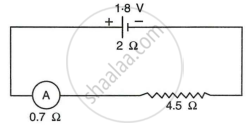Advertisements
Advertisements
Questions
Name two factors on which the internal resistance of a cell depends and state how does it depend on the factors stated by you.
State the factors on which the internal resistance of a cell depends.
Solution
Internal resistance of a cell depends upon the following factors:
- The surface area of the electrodes: Larger the surface area of the electrodes, less is the internal resistance.
- The distance between the electrodes: As the distance between the electrodes increases, the internal resistance of cell also increases. It is also affected by the nature, concentration and temperature of the solution (electrolyte).
APPEARS IN
RELATED QUESTIONS
What happens to the resistivity of semiconductor with the increase of temperature?
Explain why the p.d across the terminals of a cell is more in an open circuit and reduced in a closed circuit.
A cell of e.m.f. 1.8V and internal resistance 2Ω is connected in series with an ammeter of resistance 0.7Ω and a resistor of 4.5Ω as shown in Fig.

- What would be the reading of the ammeter?
- What is the potential difference across the terminals of the cell?
A cell of e.m.f. ε and internal resistance 𝔯 sends current 1.0 A when it is connected to an external resistance 1.9 Ω. But it sends current 0.5 A when it is connected to an external resistance 3.9 Ω. Calculate the values of ε and 𝔯.
What is the colour code for the insulation on the earth wire?
A cell of emf. 1.5 V and internal resistance 10 ohms is connected to a resistor of 5 ohms, with an ammeter in series see fig.. What is the reading of the ammeter?
Define the e.m.f. (E) of a cell and the potential difference (V) of a resistor R in terms of the work done in moving a unit charge. State the relation between these two works and the work done in moving a unit charge through a cell connected across the resistor. Take the internal resistance of the cell as ‘r’. Hence obtain an expression for the current i in the circuit.
When a resistance of 3Ω is connected across a cell, the current flowing is 0.5 A. On changing the resistance to 7Ω, the current becomes 0.25A. Calculate the e.m.f. and the internal resistance of the cell.
Explain the meaning of the term internal resistance of a cell.
A battery of e.m.f. 6·0 V supplies current through a circuit in which the resistance can be changed. A high resistance voltmeter is connected across the battery. When the current is 3 A, the voltmeter reads 5.4 V. Find the internal resistance of the battery.
